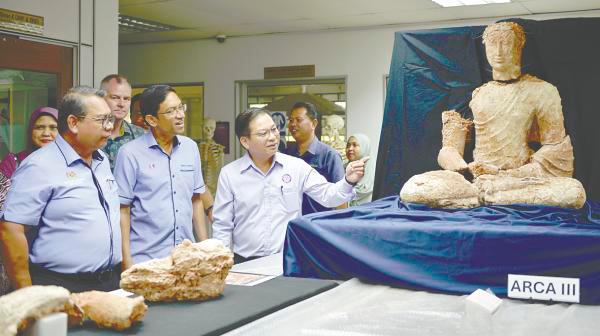ONLINE NEWS: BUDDHA STATUE FIND OFFERS INSIGHTS INTO ANCIENT KEDAH
The Sun
Buddha statue find offers insights into ancient Kedah
Oleh Qirana Nabilla Mohd Rashidi | 09 July 2024

CGAR director Prof Dr Stephen Chia Ming Soon (right) briefing Tourism, Arts and Culture Ministry Secretary-General Datuk Roslan Abdul Rahman (left) and USM vice-chancellor Prof Datuk Seri Abdul Rahman Mohamed on the artefacts on display at CGAR. – MASRY CHE ANI/THESUN
PETALING JAYA: A Buddha statue discovered at the Bukit Choras Archaeological Heritage Site in Yan, Kedah and dating to the seventh or eighth century provides valuable insights into the architecture and artistic features of ancient Kedah.
Universiti Sains Malaysia (USM) Centre for Global Archaeological Research (CGAR) project head Dr Nasha Rodziadi Khaw found the life-size sculpture that is crafted from stucco, which is a mixture of lime, water and sand.
Discovered at the north wall of a temple, the statue is undergoing conservation work at the CGAR laboratory.
“The discovery enhances our understanding of ancient Kedah civilisation and its historical context within Southeast Asia,” he said, adding that it reveals the area’s historical importance as a religious site during that period.
He said the excavation was conducted between Aug 28 and Sept 12 in 2023 and unveiled an intact structure, a well-preserved and complete Buddha statue, inscriptions, a votive tablet offered in fulfilment of a vow and other smaller objects.
He also said the discovery of the largest Buddhist temple structure in Bukit Choras dates back to the 12th century and unlike the 184 archaeological sites identified in the Bujang Valley to the south, the stupa at Bukit Choras is isolated on the northern side of Mount Jerai.
“Bukit Choras was first reported in 1850 by a British officer searching for treasures and briefly studied in 1937 by British scholar H.G. Quaritch Wales, who reported finding a square-ish Buddhist stupa but provided no illustrations.”
Nasha said the Bujang Valley Archaeological Museum director went there for site cleaning and documentation nearly 50 years later, but otherwise it remained largely undisturbed.
“I realised nobody had done a proper investigation since then and managed to get funding to survey the site in 2017.
“At first, we only excavated 40% of the site and found a stupa about nine meters long. However, the most important discovery was two stucco Buddha statues in good condition that had never been found in the area before.”
He said the statues have clear features, such as drapery, facial details, sitting position and pedestals.
“This enables us to compare the features with other complete statues found in the surrounding region and interpret the origin of the art form and possibly the religious sect that was practised at the time.”
He said managing accessibility, safety concerns due to slippery conditions and resource logistics, such as water, food, and equipment supplies, in the remote terrain required careful planning and coordination.
“Our team managed to overcome the challenges through the support of local communities, who helped prepare tracks for transporting equipment to the site.
“Our extensive experience in managing such logistical obstacles proved instrumental in overcoming the challenges.”
Nasha said findings in the area suggest that for centuries, traders from China, India and the Middle East came to Kedah for business and often stayed for extended periods due to the harsh monsoon seasons that made sailing home impossible.
“Temples and artefacts in the area were built by local labourers, who blended foreign architectural motifs and knowledge with the two main influences of Buddhism and Hinduism.
“The discovery at Bukit Choras reveals exquisite remains of intact structures and statues. This may attract visitors and provide new narratives on the interconnectivity between ancient Kedah and other regional sites, allowing us to draw connections with major sites in India and Southeast Asia.”
- Created on .
- Hits: 1257
